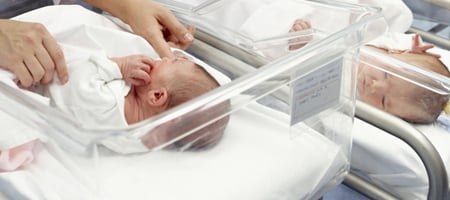Noise reduction in the neonatal unit
Premature babies are often subjected to damagingly high noise levels in hospital. The neonatal unit at Umeå University Hospital in the north of Sweden provides a good example of an alternative approach.

“Premature babies, with their growing brains, are especially sensitive to loud noises. In spite of this, neonatal units often generate a great deal of loud noise from equipment, alarms and adult voices. What’s more, an incubator vibrates like a drum, reinforcing sounds from outside,” explains Dr Johannes Van den Berg, a neonatal nursing specialist.
Neonatal units are noisy places – and all that noise goes straight into the sensitive ears of the tiny premature babies. It causes changes in heart rate and blood pressure, and the infants sleep less soundly and forget to breathe, which affects oxygenation. In their delicate state, this can lead to serious consequences such as cerebral haemorrhaging.
Probably the most extreme example of noise exposure is the transportation of premature babies by air ambulance – helicopter or plane – to receive urgent care.

Dr Johannes Van den Berg is a neonatal nursing specialist at Umeå University Hospital in northern Sweden.
Imagine having an old vacuum cleaner within a metre of your ear.
“They are exposed to noise levels of around 90 decibels. Imagine having an old vacuum cleaner within a metre of your ear – and we’re still only talking 80 decibels,” says Johannes Van den Berg, pausing for a moment. “The adults on the transport team are wearing helmets with ear muffs, but the infant’s ears are often completely unprotected in the incubator.”
Studies have shown that average noise levels in neonatal units are far higher than the 45-decibel limit recommended by the American Academy of Pediatrics. For children who have been in a neonatal intensive care unit (ICU), the risk of permanent hearing impairment is several times higher than for other children.
The neonatal ICU at Umeå University Hospital took this fact into account when it underwent renovations in 2010. The new unit is spacious, hygienic and – notably – more sound-friendly for premature babies.
The old unit typically accommodated three to five infants, along with their parents, equipment and alarm systems, in a space of 35 square metres. It should also be remembered that the parents often conversed with one another across the room. “The sheet metal ceiling in the old unit reflected back sound, adding considerably to the already high noise level,” notes Johannes Van den Berg.

In Umeå’s old neonatal unit, there was a clutter of equipment.

Umeå’s new neonatal unit provides premature babies with a more tranquil environment.
In the new unit, which measures 86 square metres, each infant and its family are accommodated in a screened-off area. The ceiling is a sound-absorbent acoustic ceiling. Pieces of equipment that tend to produce false alarms have been removed, and the rest of the equipment is placed as far away from the child’s ears as possible.
Administrative offices and overnight accommodation are located as far away from the unit as possible.Outpatients and others no longer need to walk past the neonatal unit.The unit has also reviewed its procedures, combining care and examination of infants to minimize the impact and give the child more rest.
“We are finding that the noise levels in our unit have fallen dramatically, and as a result the staff are now less stressed,” says Johannes Van den Berg.
Watch Johannes Van den Berg's lecture on acoustics in neonatal care:
Source: Dr Johannes Van den Berg
Text: Fredrik Sieradzki
Photo: Elin Ohlsson and Johannes Van den Berg
